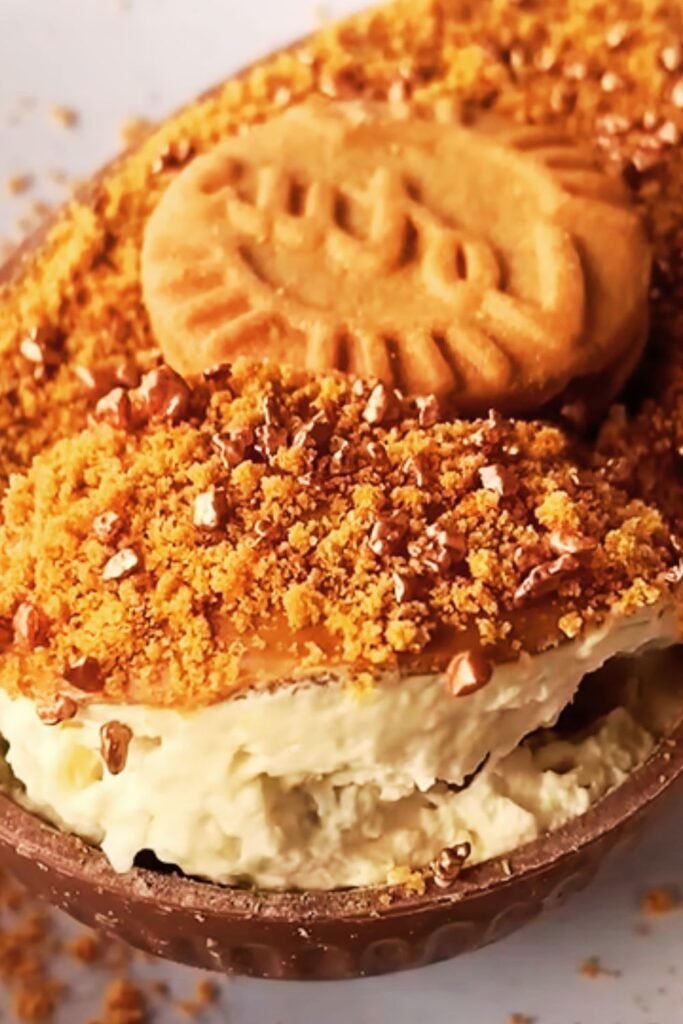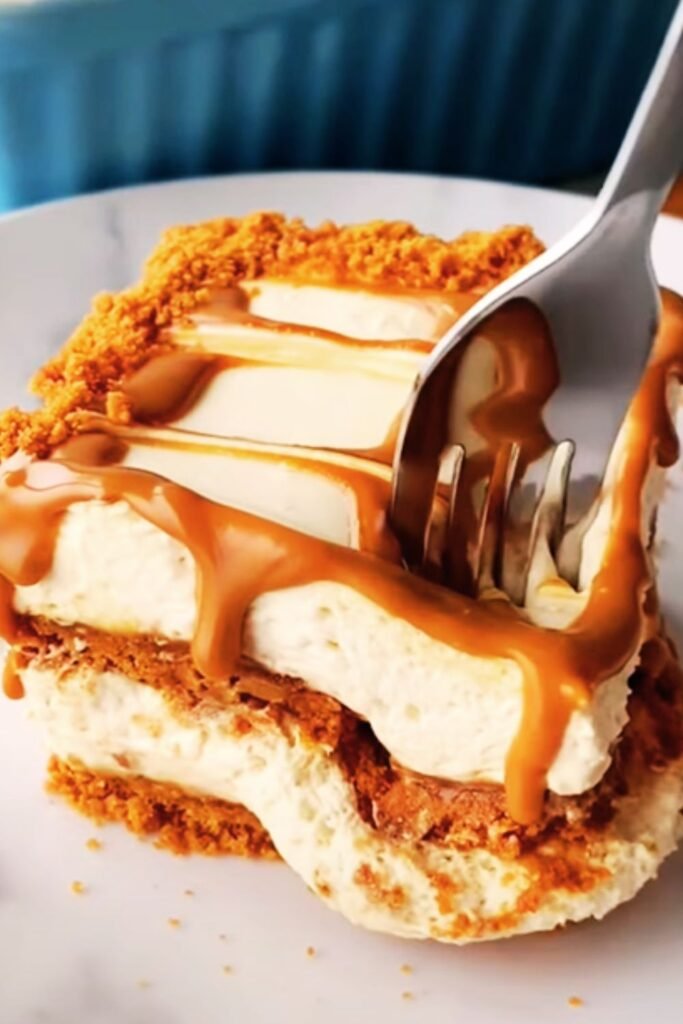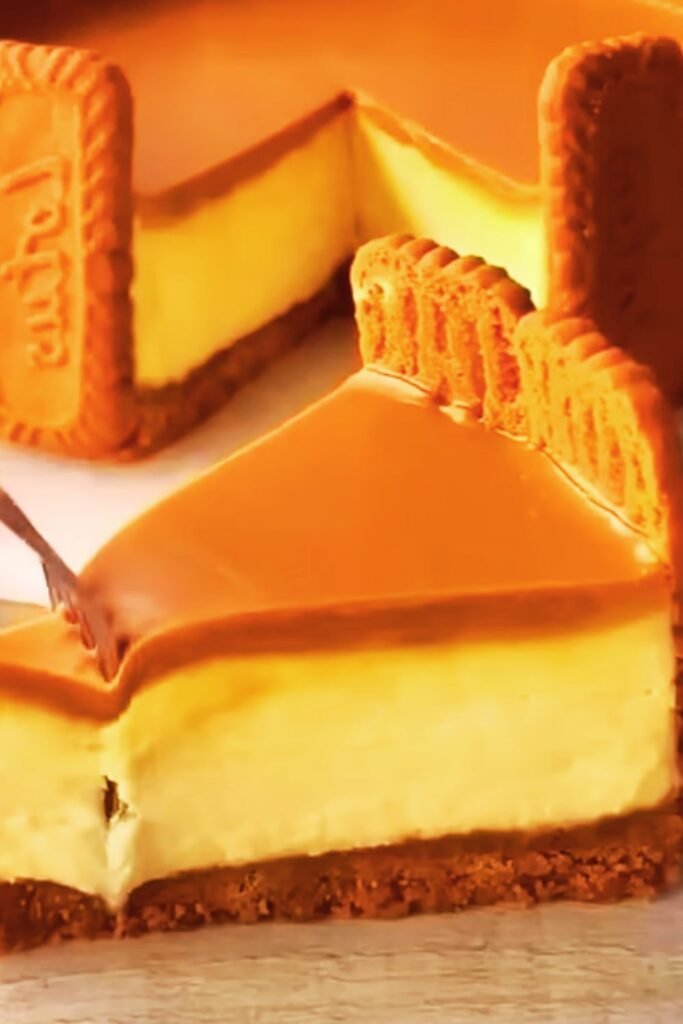There’s something magical about the warm, spiced flavor of Biscoff cookies that makes them utterly irresistible. If you’re as obsessed with these caramelized spice cookies as I am, you’re in for a real treat today! I’m sharing my absolute favorite Biscoff cheesecake recipe that perfectly captures that distinctive speculoos flavor in a luxuriously creamy dessert.
The first time I made this Biscoff cheesecake, it disappeared within hours at a family gathering. Now it’s my most requested dessert for special occasions. What makes it so special? It’s the perfect balance of that iconic Biscoff cookie flavor in three magnificent layers: a crunchy cookie base, a silky-smooth cheesecake filling infused with cookie butter, and a glossy Biscoff spread topping that adds the perfect finishing touch.
Let me walk you through creating this showstopper dessert that’ll have everyone asking for seconds!
Ingredients
For the Base:
- 300g Lotus Biscoff cookies (approximately 2 packets)
- 100g unsalted butter, melted
- 1 tablespoon granulated sugar (optional for extra sweetness)
For the Cheesecake Filling:
- 600g full-fat cream cheese, room temperature
- 250g smooth Biscoff spread (cookie butter)
- 100g granulated sugar
- 3 large eggs, room temperature
- 1 teaspoon vanilla extract
- 200ml sour cream
- 2 tablespoons all-purpose flour
For the Topping:
- 200g smooth Biscoff spread
- 100ml heavy cream
- Lotus Biscoff cookies for decoration (approximately 6-8 cookies)
- 2 tablespoons crushed Biscoff cookies for sprinkling
Essential Equipment
- 9-inch (23cm) springform pan
- Parchment paper
- Food processor (or rolling pin and plastic bag for crushing cookies)
- Electric mixer (stand or hand mixer)
- Mixing bowls
- Spatula
- Measuring cups and spoons
- Cooling rack
Step-by-Step Instructions
Preparing the Base
- Preheat your oven to 160°C (320°F) fan-forced or 180°C (350°F) conventional.
- Line the bottom of your springform pan with parchment paper and lightly grease the sides.
- Place the Biscoff cookies in a food processor and pulse until they form fine crumbs. (No food processor? Place cookies in a sealed plastic bag and crush with a rolling pin.)
- Transfer the cookie crumbs to a mixing bowl, add the sugar if using, and pour in the melted butter.
- Mix thoroughly until the crumbs are evenly moistened and resemble wet sand.
- Press the mixture firmly into the base of your springform pan, creating an even layer.
- Bake for 10 minutes, then remove from the oven and let cool while preparing the filling.
- Reduce the oven temperature to 150°C (300°F) fan-forced or 170°C (325°F) conventional.
Creating the Cheesecake Filling
- In a large mixing bowl, beat the cream cheese on medium speed until smooth and creamy, about 2 minutes.
- Add the Biscoff spread and sugar, beating until completely incorporated and smooth.
- Add the eggs one at a time, beating well between each addition and scraping down the sides of the bowl as needed.
- Mix in the vanilla extract.
- Add the sour cream and beat until just combined.
- Sift in the flour and fold gently using a spatula until fully incorporated.
- Pour the filling over the cooled cookie base, smoothing the top with a spatula.
Baking the Cheesecake
- Wrap the bottom and sides of your springform pan in aluminum foil to prevent water seepage. This is optional but recommended for a water bath.
- Place the wrapped pan in a larger roasting pan and add hot water to reach about halfway up the sides of the springform pan.
- Carefully transfer to the oven and bake for 50-60 minutes. The cheesecake is done when the edges are set but the center still has a slight wobble.
- Turn off the oven, leave the door slightly ajar, and allow the cheesecake to cool in the oven for 1 hour.
- Remove from the oven and water bath, and cool completely at room temperature.
- Refrigerate for at least 4 hours, preferably overnight.
Preparing the Topping
- In a microwave-safe bowl, heat the Biscoff spread for about 30 seconds until it’s slightly runny.
- In a separate bowl, lightly whip the heavy cream until it begins to thicken but is still pourable.
- Gently fold the whipped cream into the warm Biscoff spread until smooth and well combined.
- Let the mixture cool slightly before spreading it over the chilled cheesecake.
- Smooth the top with a spatula or the back of a spoon.
- Arrange whole Biscoff cookies around the edge of the cheesecake, standing them up vertically.
- Sprinkle crushed Biscoff cookies in the center for a decorative finish.
- Return to the refrigerator for at least 1 hour to set the topping.

Pro Tips for the Perfect Biscoff Cheesecake
Having made this cheesecake countless times, I’ve gathered some invaluable tips to ensure your dessert is absolutely perfect:
- Room temperature ingredients: Make sure your cream cheese, eggs, and sour cream are at room temperature before starting. Cold ingredients don’t blend as smoothly and can lead to lumps.
- Don’t overmix: Once you add the eggs, mix just until incorporated. Overmixing can incorporate too much air, causing the cheesecake to rise and then crack as it cools.
- Water bath benefits: Using a water bath creates steam in the oven, which helps prevent cracks and ensures even baking. If you skip this step, you might need to cover any cracks with the topping later.
- Cooling gradually: The slow cooling process in the turned-off oven prevents the cheesecake from cooling too quickly, which can cause cracking.
- Overnight chilling: For the best flavor and texture, try to chill the cheesecake overnight. This allows the flavors to meld beautifully and ensures the perfect consistency.
- Clean slicing: For picture-perfect slices, dip your knife in hot water and wipe clean between each cut.
Nutrition Information
| Nutrient | Amount per Serving (1/12 slice) |
|---|---|
| Calories | 620 |
| Total Fat | 42g |
| – Saturated Fat | 23g |
| Cholesterol | 135mg |
| Sodium | 320mg |
| Total Carbohydrates | 54g |
| – Dietary Fiber | 1g |
| – Sugars | 39g |
| Protein | 7g |
Note: Nutritional information is approximate and may vary based on specific ingredients used.
Storage and Make-Ahead Instructions
This Biscoff cheesecake stores beautifully, making it perfect for preparing ahead for special occasions:
- Refrigerator: Store covered in the refrigerator for up to 5 days. The flavor actually improves after a day!
- Freezer: Freeze individual slices or the whole cheesecake (without topping) for up to 3 months. Wrap tightly in plastic wrap and then aluminum foil.
- Thawing: Thaw frozen cheesecake overnight in the refrigerator before adding the topping and serving.

Variations and Substitutions
While the classic recipe is absolutely divine, here are some creative variations you might enjoy:
White Chocolate Biscoff Cheesecake
Add 150g of melted white chocolate to the cheesecake filling for an extra layer of decadence.
Biscoff Swirl Cheesecake
Instead of incorporating all the Biscoff spread into the filling, swirl some through the batter before baking for a beautiful marbled effect.
Gluten-Free Option
Use gluten-free speculoos-style cookies for the base and ensure your Biscoff-style spread is gluten-free.
Vegan Alternative
Substitute dairy ingredients with vegan cream cheese, plant-based butter, coconut cream, and use a flax egg replacement. Note that the texture will be slightly different.
Mini Biscoff Cheesecakes
Use a muffin tin lined with paper cases to create individual servings. Reduce baking time to about 20 minutes.
Serving Suggestions
To take your Biscoff cheesecake presentation to the next level:
- Dust with a light sprinkle of cinnamon or cocoa powder
- Add a dollop of whipped cream to each slice
- Drizzle with warm Biscoff spread just before serving
- Serve with fresh berries for a colorful contrast
- Pair with a hot cup of coffee or tea
- For special occasions, add a scoop of vanilla ice cream on the side

Common Troubleshooting
My cheesecake cracked!
Don’t worry! The Biscoff topping will cover any cracks perfectly. For future attempts, make sure you’re using a water bath and cooling the cheesecake gradually.
The filling seems too runny
If your filling seems too liquid before baking, chill it in the refrigerator for 15-20 minutes to firm up slightly.
My base is too hard
You may have compacted the crumbs too firmly or used too much butter. Next time, press more gently and make sure your butter-to-crumb ratio is correct.
The topping won’t set
If your topping is too runny, it might need more time in the refrigerator, or you may need to add a bit more whipped cream for structure.
Frequently Asked Questions
Can I use crunchy Biscoff spread instead of smooth? Absolutely! Crunchy Biscoff spread will add a lovely texture to your cheesecake filling, though the smooth variety creates the most luxurious texture.
How do I know when my cheesecake is done baking? The edges should be set, but the center should still have a slight wobble when you gently shake the pan. It will continue to set as it cools.
Can I make this cheesecake without a springform pan? Yes, though a springform pan makes removal much easier. If using a regular cake pan, line the bottom and sides with parchment paper with overhang to help lift the cheesecake out once set.
What if I can’t find Biscoff cookies or spread? Any speculoos cookies and cookie butter spread will work. Graham crackers can be substituted for the base in a pinch, though the flavor profile will be different.
Can I reduce the sugar in this recipe? Yes, you can reduce the added sugar by up to half, as the Biscoff cookies and spread already provide sweetness. However, this may affect the texture slightly.
Why did my cheesecake sink in the middle? A slight dip in the center is normal. Significant sinking usually indicates it was underbaked or cooled too quickly. The topping will fill in any depression.
Is this recipe suitable for beginners? Absolutely! While cheesecakes have a reputation for being tricky, following the detailed steps in this recipe will help ensure success even for first-time bakers.
Final Thoughts
This Biscoff cheesecake is truly a labor of love that’s worth every minute spent in the kitchen. The combination of the spiced cookie base, creamy Biscoff-infused filling, and luscious topping creates a dessert that’s memorable enough for special occasions yet simple enough to make whenever the craving strikes.
The beautiful thing about this recipe is how the distinct caramelized spice flavor of Biscoff permeates every layer, creating a harmonious dessert that’s greater than the sum of its parts. I’ve served this cheesecake at birthdays, holiday gatherings, and casual family dinners, and it never fails to impress.
So go ahead, treat yourself and your loved ones to this irresistible Biscoff cheesecake. Just be prepared for it to become your new signature dessert – and for the recipe requests that will inevitably follow!